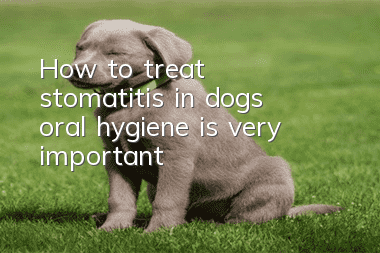How to treat stomatitis in dogs: oral hygiene is very important

Treatment methods for dog stomatitis
1. Eliminate the cause: remove foreign objects that damage the dog’s oral mucosa, trim sharp teeth, and stop taking irritating drugs.2. Strengthen care: Feed the dog liquid food, drink plenty of water, rinse the dog’s mouth with water after feeding, etc.
3. Generally, 1% saline solution, 2-3% boric acid solution, or 2-3% sodium bicarbonate solution can be used to rinse the dog's mouth 2-3 times a day.
4. When the dog’s mouth smells bad, you can use 0.1% potassium permanganate solution to rinse the mouth.
5. When your dog has excessive saliva, you can use 1% alum or tannic acid solution to rinse your mouth.
6. When there are erosions and ulcers on the dog’s oral mucosa or tongue surface, after rinsing the mouth, use iodine glycerin (1 part of 5% iodine, 9 parts of glycerin), or 2% gentian violet or 1% sulfonamide Apply glycerin emulsion to the wound 2-3 times a day.
7. For severe stomatitis, the dog can be given a sulfa-alum mixture in its mouth or take the traditional Chinese medicine Qingdai powder, which will have a good effect.
Common causes of dog stomatitis
1. The most common cause is direct damage to the oral mucosa by thick and hard bones, sharp teeth, nails, wires, etc., and then secondary infection leads to oral cavity rupture. inflammation.2. The second is the accidental ingestion of quicklime, ammonia, moldy feed, and excessively concentrated irritating drugs.
3. Secondary to tongue injury, pharyngitis or certain infectious diseases.
Common symptoms of dog stomatitis
1. The sick dog refuses to eat rough and hard feed, and likes to eat liquid feed and soft meat. It swallows it without chewing or chews it a few times and spits out the food bolus. .2. Saliva increases and appears as white foam attached to the lips, or flows out in the form of threads.
3. When inflammation is severe, salivation will be more obvious. When examining the oral cavity, it can be seen that the mucous membrane is flushed and swollen, the oral temperature is increased, the patient feels allergic, and the exhaled breath has a foul odor.
4. In vesicular stomatitis, blisters of varying sizes can be seen.
5. In ulcerative stomatitis, erosion, necrosis or ulcers can be seen on the mucous membrane.
Random articles
- What do dogs eat to protect their stomach? It is important to protect their stomach and treat gastrointestinal diseases in dogs.
- How to tell if your dog is fat? Is your dog overweight?
- Will your dog catch a cold if you blow the air conditioner? What should you do if your dog catches a cold if you blow the air conditioner?
- What should you pay attention to when your dog drinks water? Don’t be careless when it comes to your dog’s drinking water.
- The dog's mouth bites and shakes. Why does the dog's mouth occasionally shake and bite?
- How to cut a dog's hair? Do you know how to cut a dog's hair correctly?
- Can dogs eat raw eggs? Why can’t dogs eat egg whites?
- Common Dog Problems in Summer How to Deal with Different Dog Problems
- How to keep dogs away from skin diseases. If you do this, will you see if your dog will still be infected with skin diseases?
- What causes anorexia in dogs? Dogs will become anorexic due to lack of exercise. Hounds run at least 5KM every day.



